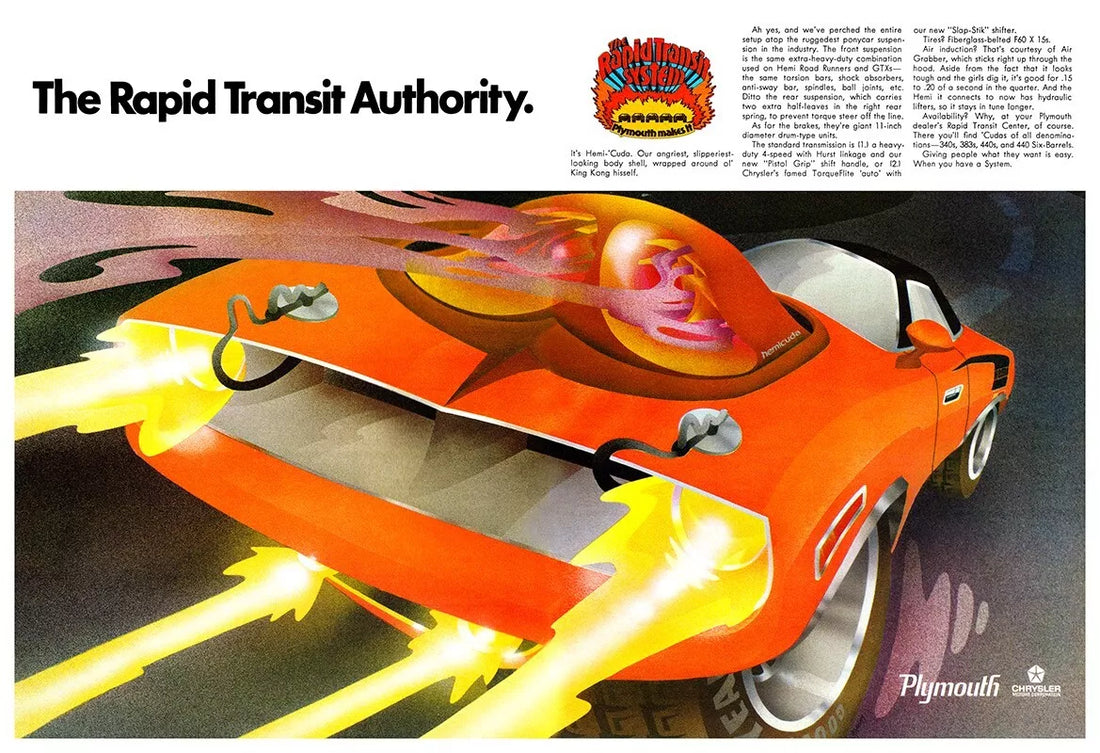
The Rapid Transit System: Plymouth’s Wildest Era and the $2.2M Show Car I Watched Sell
Darrien EouseThe Rapid Transit System: Plymouth’s Wildest Era and the $2.2M Show Car I Watched Sell
There’s a lot of marketing fluff in the classic car world—but every now and then, something actually lives up to the legend. The Rapid Transit System wasn’t just a clever campaign. It was Mopar at its loudest, boldest, and most unapologetic, and it gave us some of the most collectible muscle cars ever built.
I’ve been in the auction world a long time, and I’ve handled everything from unrestored tin signs to full six-figure neon collections—but I’ll never forget the day we sold one of the original Rapid Transit System show cars at Mecum for over $2.2 million. I was there, working on the auction team. It was a surreal moment, and one that reminded me just how important this chapter of Mopar history really is.
What Was the Rapid Transit System?
Launched by Plymouth in 1970, the Rapid Transit System (RTS) was Chrysler’s high-performance branding push aimed squarely at young buyers. It wasn’t just a badge or a trim package—it was a full-on movement. If you walked into a Plymouth dealership back
then, you’d find RTS posters, parts counters decked out with wild cartoon art, and performance brochures showcasing a lineup that included the ’Cuda, Duster 340, Road Runner, and GTX.
But what really set the campaign apart was its use of over-the-top custom show cars—designed to stop traffic and leave an impression.
The RTS Caravan: Mopar’s Traveling Freak Show
To promote the lineup, Chrysler commissioned a group of factory show cars and sent them across the country in what became known as the Rapid Transit Caravan. These weren’t your average muscle cars. Each one was modified by custom car builder Chuck Miller, with wild flares, nose cones, wild paint schemes, and graphics straight out of a comic book.
The goal was simple: get attention. And it worked. These cars toured the U.S., drawing crowds at dealerships, shopping malls, and car shows. They were part muscle car, part rolling billboard, and completely unforgettable.
The Car That Sold for $2.2 Million
Fast forward decades later—most people thought the RTS show cars were long gone. But one resurfaced: a 1970 Plymouth Road Runner that was part of the original Caravan. It still had its signature custom bodywork, including the pointed nose, oversized fenders, and bold graphics. And in January 2023 at Mecum Kissimmee, I was on the auction team that sold it for $2.2 million. It was unforgettable.
If you haven't been to a their auctions, you need to. They'll be back in Kissimmee again for the Summer Spectacular in July.
Watching that hammer drop was one of the coolest moments I’ve had in this business. Not just because of the price—but because of what it represented. It was proof that these cars, this era, and this kind of storytelling still matter. They’re not just machines—they’re history you can start.
Why It Still Matters to Collectors
Ask any serious Mopar guy what gets his heart going, and odds are it’s not just the horsepower. It’s the whole world around it—the artwork, the advertising, the characters like Mr. Horsepower, Mr. Norm, Road Runner, or the Super Bee, and yes, the Rapid Transit System.
What makes RTS so collectible isn’t just rarity. It’s the attitude. These were the loudest cars from the loudest brand during the wildest time in Detroit history. They represent everything that made American muscle cars great—raw power, no apologies, and styling that wasn’t afraid to get weird.
Carrying That Legacy Forward
We’ve made it a point to honor that era—by capturing the spirit behind it. Whether it’s a Super Bee neon sign or a tribute to the Rapid Transit retro art style, the goal is always the same: do it right, or don’t do it at all.
That $2.2M Road Runner? That wasn’t just a win for one seller. It was a win for everyone who still believes this stuff matters. I was proud to be part of the auction team that sold it. And I’m even prouder to carry that legacy forward, one sign at a time.






















